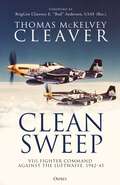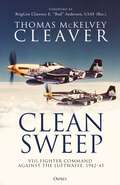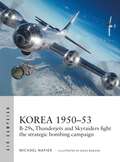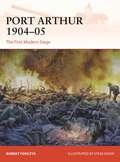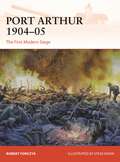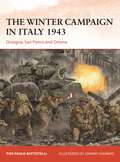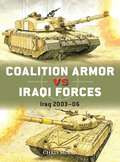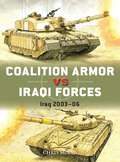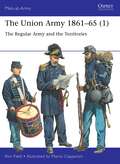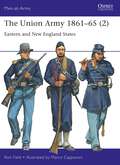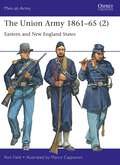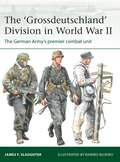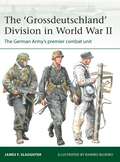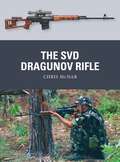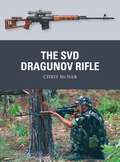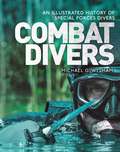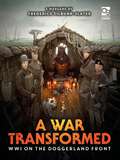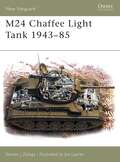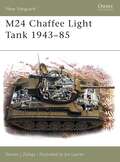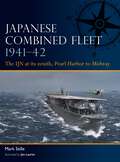- Table View
- List View
Clean Sweep: VIII Fighter Command against the Luftwaffe, 1942–45
by Thomas McKelvey CleaverA vivid narrative history, packed with first-hand accounts, of the US Eighth Air Force's VIII Fighter Command from its foundation in 1942 through to its victory in the skies over Nazi Germany.On August 7, 1942, two events of major military importance occurred on separate sides of the planet. In the South Pacific, the United States went on the offensive, landing the First Marine Division at Guadalcanal. In England, 12 B-17 bombers of the new Eighth Air Force's 97th Bombardment Group bombed the Rouen–Sotteville railroad marshalling yards in France. While the mission was small, the aerial struggle that began that day would ultimately cost the United States more men killed and wounded by the end of the war in Europe than the Marines would lose in the Pacific War. Clean Sweep is the story of the creation, development and operation of the Eighth Air Force Fighter Command and the battle to establish daylight air superiority over the Luftwaffe so that the invasion of Europe could be successful.Thomas McKelvey Cleaver has had a lifelong interest in the history of the fighter force that defeated the Luftwaffe over Germany. He has collected many first-hand accounts from participants over the past 50 years, getting to know pilots such as the legendary “Hub” Zemke, Don Blakeslee and Chuck Yeager, as well as meeting and interviewing leading Luftwaffe pilots Adolf Galland, Gunther Rall and Walter “Count Punski” Krupinski. This story is told through accounts gathered from both sides.
Clean Sweep: VIII Fighter Command against the Luftwaffe, 1942–45
by Thomas McKelvey CleaverA vivid narrative history, packed with first-hand accounts, of the US Eighth Air Force's VIII Fighter Command from its foundation in 1942 through to its victory in the skies over Nazi Germany.On August 7, 1942, two events of major military importance occurred on separate sides of the planet. In the South Pacific, the United States went on the offensive, landing the First Marine Division at Guadalcanal. In England, 12 B-17 bombers of the new Eighth Air Force's 97th Bombardment Group bombed the Rouen–Sotteville railroad marshalling yards in France. While the mission was small, the aerial struggle that began that day would ultimately cost the United States more men killed and wounded by the end of the war in Europe than the Marines would lose in the Pacific War. Clean Sweep is the story of the creation, development and operation of the Eighth Air Force Fighter Command and the battle to establish daylight air superiority over the Luftwaffe so that the invasion of Europe could be successful.Thomas McKelvey Cleaver has had a lifelong interest in the history of the fighter force that defeated the Luftwaffe over Germany. He has collected many first-hand accounts from participants over the past 50 years, getting to know pilots such as the legendary “Hub” Zemke, Don Blakeslee and Chuck Yeager, as well as meeting and interviewing leading Luftwaffe pilots Adolf Galland, Gunther Rall and Walter “Count Punski” Krupinski. This story is told through accounts gathered from both sides.
Korea 1950–53: B-29s, Thunderjets and Skyraiders fight the strategic bombing campaign (Air Campaign #39)
by Michael NapierA spectacularly illustrated new history and analysis of the strategic bombing campaign in the Korean War, which saw the last combat of America's legendary B-29s. Just five years after they defeated Japan, at the dawn of the jet age, the most advanced bomber of World War II was already obsolescent. But the legendary war-winning Superfortresses had one more war to fight, in the strategic air campaign against North Korea. The bombers' task was to destroy North Korea's facilities for waging war, from industry and hydroelectric dams to airfields and bridges. However, it was a challenging campaign, in which the strategy was not merely military but political. In this fascinating book, airpower scholar and former RAF pilot Michael Napier explains how the campaign was fought, and how the technique of 'bombing to negotiate' that would become notorious in Vietnam was already being used in Korea. He analyses in detail the relationship between battlefield progress, armistice negotiations and the bombing strategy developed over the complex campaign. In the skies over Korea, the B-29s operated in a new world dominated by jet fighters and jet age technology, and tactics were developing rapidly. Packed with original illustrations, this book includes dramatic air scenes featuring B-29s, MiG-15s, AD Skyraiders and Skyknight jet nightfighters in action. It also includes maps, 3D recreations of missions and explanatory 3D diagrams to bring the conflict to life. This is a fascinating, dramatic account of the last battles of the piston-engined aircraft era as the superpowers vied for victory in the first clash of the Cold War.
Korea 1950–53: B-29s, Thunderjets and Skyraiders fight the strategic bombing campaign (Air Campaign #39)
by Michael NapierA spectacularly illustrated new history and analysis of the strategic bombing campaign in the Korean War, which saw the last combat of America's legendary B-29s. Just five years after they defeated Japan, at the dawn of the jet age, the most advanced bomber of World War II was already obsolescent. But the legendary war-winning Superfortresses had one more war to fight, in the strategic air campaign against North Korea. The bombers' task was to destroy North Korea's facilities for waging war, from industry and hydroelectric dams to airfields and bridges. However, it was a challenging campaign, in which the strategy was not merely military but political. In this fascinating book, airpower scholar and former RAF pilot Michael Napier explains how the campaign was fought, and how the technique of 'bombing to negotiate' that would become notorious in Vietnam was already being used in Korea. He analyses in detail the relationship between battlefield progress, armistice negotiations and the bombing strategy developed over the complex campaign. In the skies over Korea, the B-29s operated in a new world dominated by jet fighters and jet age technology, and tactics were developing rapidly. Packed with original illustrations, this book includes dramatic air scenes featuring B-29s, MiG-15s, AD Skyraiders and Skyknight jet nightfighters in action. It also includes maps, 3D recreations of missions and explanatory 3D diagrams to bring the conflict to life. This is a fascinating, dramatic account of the last battles of the piston-engined aircraft era as the superpowers vied for victory in the first clash of the Cold War.
Port Arthur 1904–05: The First Modern Siege (Campaign #398)
by Robert ForczykA gripping, illustrated narrative of the longest and most brutal land battle of the 1904–05 Russo-Japanese War.Growing rivalry between Imperial Russia and Imperial Japan over territorial control in China and Korea led to the outbreak of war in February 1904. Japan struck the first blow with a surprise naval attack against the anchored Russian Pacific Fleet at its base in Port Arthur. Once the fleet had been neutralized, the Japanese landed their Second Army on the Liaotung Peninsula in May 1904, in order to besiege Port Arthur. The fighting that followed has become legend in military history. Respected military historian Robert Forczyk describes the Russian relief operation towards Port Arthur (the Battle of Telissu), and the lengthy siege of the Russian-held town and harbour. The initial Japanese attempts to capture the port by assault are documented in detail, together with the Japanese progress through the heavily fortified lines protecting Port Arthur. Specially commissioned artworks bring to life in vivid detail the Battle of Nanshan Hill, the Japanese assault on the Wantai Heights, and the bombardments of the Russian forts. Maps and diagrams explore the strategic situation and tactical progress of the fighting in step-by-step detail, and over 60 period photographs reveal the appearance and weaponry of the opposing forces and the terrain around Port Arthur.
Port Arthur 1904–05: The First Modern Siege (Campaign #398)
by Robert ForczykA gripping, illustrated narrative of the longest and most brutal land battle of the 1904–05 Russo-Japanese War.Growing rivalry between Imperial Russia and Imperial Japan over territorial control in China and Korea led to the outbreak of war in February 1904. Japan struck the first blow with a surprise naval attack against the anchored Russian Pacific Fleet at its base in Port Arthur. Once the fleet had been neutralized, the Japanese landed their Second Army on the Liaotung Peninsula in May 1904, in order to besiege Port Arthur. The fighting that followed has become legend in military history. Respected military historian Robert Forczyk describes the Russian relief operation towards Port Arthur (the Battle of Telissu), and the lengthy siege of the Russian-held town and harbour. The initial Japanese attempts to capture the port by assault are documented in detail, together with the Japanese progress through the heavily fortified lines protecting Port Arthur. Specially commissioned artworks bring to life in vivid detail the Battle of Nanshan Hill, the Japanese assault on the Wantai Heights, and the bombardments of the Russian forts. Maps and diagrams explore the strategic situation and tactical progress of the fighting in step-by-step detail, and over 60 period photographs reveal the appearance and weaponry of the opposing forces and the terrain around Port Arthur.
The Winter Campaign in Italy 1943: Orsogna, San Pietro and Ortona (Campaign #395)
by Pier Paolo BattistelliA gripping tale of three crucial battles fought at the end of 1943 as Allied forces approached the Gustav Line in Italy.After repulsing the German counter-attack at Salerno in September 1943, the US Fifth Army and British Eighth Army advanced up the Italian Peninsula. By October, the Allied armies had reached the Volturno Line, forcing a critical decision in German strategy: a prolonged defence would be conducted in southern Italy, contesting the Allied advance using the complex terrain features. By mid-November, the two Allied armies were approaching the German defensive lines along the Garigliano and the Sangro rivers. Here, US 5th Army would attack through the Mignano gap towards San Pietro Infine, while British Eighth Army would seize Ortona on the Adriatic coast and Orsogna. A brutal struggle ensued, with the German defenders attempting to hold their positions. The fighting at Ortona in particular (labelled a 'mini Stalingrad') would be particularly grueling for the Canadian forces involved. This fascinating work focuses on several little-known battles fought in Italy following the German withdrawal from the Salerno bridgehead and from Taranto. Maps and diagrams present an easy to follow overview of the multiple operations of this complex campaign. The forces of the opposing sides (including American, German, Canadian, New Zealand and British troops), and the three decisive battles fought in late 1943, are brought vividly to life in period photos and superb battlescene artworks.
The Winter Campaign in Italy 1943: Orsogna, San Pietro and Ortona (Campaign #395)
by Pier Paolo BattistelliA gripping tale of three crucial battles fought at the end of 1943 as Allied forces approached the Gustav Line in Italy.After repulsing the German counter-attack at Salerno in September 1943, the US Fifth Army and British Eighth Army advanced up the Italian Peninsula. By October, the Allied armies had reached the Volturno Line, forcing a critical decision in German strategy: a prolonged defence would be conducted in southern Italy, contesting the Allied advance using the complex terrain features. By mid-November, the two Allied armies were approaching the German defensive lines along the Garigliano and the Sangro rivers. Here, US 5th Army would attack through the Mignano gap towards San Pietro Infine, while British Eighth Army would seize Ortona on the Adriatic coast and Orsogna. A brutal struggle ensued, with the German defenders attempting to hold their positions. The fighting at Ortona in particular (labelled a 'mini Stalingrad') would be particularly grueling for the Canadian forces involved. This fascinating work focuses on several little-known battles fought in Italy following the German withdrawal from the Salerno bridgehead and from Taranto. Maps and diagrams present an easy to follow overview of the multiple operations of this complex campaign. The forces of the opposing sides (including American, German, Canadian, New Zealand and British troops), and the three decisive battles fought in late 1943, are brought vividly to life in period photos and superb battlescene artworks.
Coalition Armor vs Iraqi Forces: Iraq 2003–06 (Duel #133)
by Chris McNabAn illustrated study of how coalition armor in Iraq in 2003–06 handled a unique multi-threat environment, from enemy armor to IEDs.On 20 March 2003, Coalition forces launched the invasion of Iraq on a massive scale. Their armored fighting vehicles (AFVs) faced an uncertain level of resistance, and soon had to overcome a wide range of enemy threats. These included tank vs tank clashes during the first days of the invasion (most famously at Basra and Mahmoudiyah), and subsequently the dangers posed by enemy rocket-propelled grenades, cannon fire, antitank guided missiles, and improvised explosive devices.This vital new study covers both the opening clashes between opposing AVFs and the tactics developed by Iraqi insurgents seeking to neutralize Coalition superiority. Featuring full color photos, battle scenes, weaponry, and tactical illustrations, it draws upon first-hand accounts and official post-battle analyses to examine how Coalition forces responded to the change in the nature of the threats. Among the topics addressed are the coordination between Coalition infantry and air power; how dealing with roadside bombs in Iraq resulted in changes to equipment, tactics, and force structure; and the lessons learned for future warfare.
Coalition Armor vs Iraqi Forces: Iraq 2003–06 (Duel #133)
by Chris McNabAn illustrated study of how coalition armor in Iraq in 2003–06 handled a unique multi-threat environment, from enemy armor to IEDs.On 20 March 2003, Coalition forces launched the invasion of Iraq on a massive scale. Their armored fighting vehicles (AFVs) faced an uncertain level of resistance, and soon had to overcome a wide range of enemy threats. These included tank vs tank clashes during the first days of the invasion (most famously at Basra and Mahmoudiyah), and subsequently the dangers posed by enemy rocket-propelled grenades, cannon fire, antitank guided missiles, and improvised explosive devices.This vital new study covers both the opening clashes between opposing AVFs and the tactics developed by Iraqi insurgents seeking to neutralize Coalition superiority. Featuring full color photos, battle scenes, weaponry, and tactical illustrations, it draws upon first-hand accounts and official post-battle analyses to examine how Coalition forces responded to the change in the nature of the threats. Among the topics addressed are the coordination between Coalition infantry and air power; how dealing with roadside bombs in Iraq resulted in changes to equipment, tactics, and force structure; and the lessons learned for future warfare.
The Union Army 1861–65: The Regular Army and the Territories (Men-at-Arms #553)
by Ron FieldThis fully illustrated study investigates the uniforms and equipment of the US regular troops and volunteers from the territories fighting for the Union during the American Civil War.During the American Civil War, the United States Army, pitted against the forces of the fledgling Confederacy, fought to defend and preserve the Union during five long years of bitter conflict. This volume describes and illustrates the uniforms, insignia and personal equipment of the Union Army's regular infantry, artillery, cavalry, and engineers, plus specialists such as US Sharpshooters, Veteran Reserve Corps, Medical Corps, and Signal Corps.This volume also covers the troops fielded by the Territories that fought for the Union. Eight plates of original artwork showing officers and enlisted men of the Union Army are complemented by previously unpublished photographs of soldiers and items of uniform from some of the most comprehensive collections in the United States.
The Union Army 1861–65: The Regular Army and the Territories (Men-at-Arms #553)
by Ron FieldThis fully illustrated study investigates the uniforms and equipment of the US regular troops and volunteers from the territories fighting for the Union during the American Civil War.During the American Civil War, the United States Army, pitted against the forces of the fledgling Confederacy, fought to defend and preserve the Union during five long years of bitter conflict. This volume describes and illustrates the uniforms, insignia and personal equipment of the Union Army's regular infantry, artillery, cavalry, and engineers, plus specialists such as US Sharpshooters, Veteran Reserve Corps, Medical Corps, and Signal Corps.This volume also covers the troops fielded by the Territories that fought for the Union. Eight plates of original artwork showing officers and enlisted men of the Union Army are complemented by previously unpublished photographs of soldiers and items of uniform from some of the most comprehensive collections in the United States.
The Union Army 1861–65: Eastern and New England States (Men-at-Arms #555)
by Ron FieldThis book describes and illustrates the uniforms and personal equipment of the troops fielded by the Eastern and New England states that fought for the Union during the American Civil War. During 1861–65, the United States Army, pitted against the forces of the fledgling Confederacy, fought to defend the Union during five long years of bitter conflict. This volume, the second in a three-part study, chronicles the clothing, insignia and gear worn by the soldiers fielded by 12 of the states that fought to preserve the Union. While uniforms conforming to standard Union Army patterns were widely issued to these troops, some wore distinctive items of dress or insignia, and a wide variety of weapons were carried. Ron Field, an acknowledged authority on US military apparel, reveals how the Eastern and New England states clothed and equipped their regiments during the Civil War. Eight plates of original artwork showing officers and enlisted men of the Union Army are complemented by photographs of soldiers and items of uniform from a variety of sources.
The Union Army 1861–65: Eastern and New England States (Men-at-Arms #555)
by Ron FieldThis book describes and illustrates the uniforms and personal equipment of the troops fielded by the Eastern and New England states that fought for the Union during the American Civil War. During 1861–65, the United States Army, pitted against the forces of the fledgling Confederacy, fought to defend the Union during five long years of bitter conflict. This volume, the second in a three-part study, chronicles the clothing, insignia and gear worn by the soldiers fielded by 12 of the states that fought to preserve the Union. While uniforms conforming to standard Union Army patterns were widely issued to these troops, some wore distinctive items of dress or insignia, and a wide variety of weapons were carried. Ron Field, an acknowledged authority on US military apparel, reveals how the Eastern and New England states clothed and equipped their regiments during the Civil War. Eight plates of original artwork showing officers and enlisted men of the Union Army are complemented by photographs of soldiers and items of uniform from a variety of sources.
The 'Grossdeutschland' Division in World War II: The German Army's premier combat unit (Elite #255)
by Professor James F. SlaughterInvestigates the history and evolving appearance of the 'Grossdeutschland' Division, the German Army's premier combat unit during World War II. Featuring eight pages of original artwork and carefully chosen photographs depicting personalities, uniforms, insignia and personal equipment, this is the absorbing story of the German Army's elite 'fire brigade' during 1939–45. The unit began its life as an elite guard detachment; expanded to regimental size in 1939, it saw action in France in 1940 and Yugoslavia in 1941 before participating in the Axis invasion of the Soviet Union. Reinforced to divisional status, 'Grossdeutschland' fought on the Eastern Front in 1942–44, notably at Rzhev in late 1942 and Kharkov in early 1943. Refitted and redesignated a Panzergrenadier-Division, 'Grossdeutschland' played a key role in the battle of Kursk in July 1943, before acting as the Wehrmacht's 'fire brigade' in 1943–44. In late 1944, 'Grossdeutschland' was expanded to Panzerkorps status, with Panzergrenadier-Division 'Brandenburg' also taking the field. Further units joined the order of battle, the Führerbegleit-Brigade fighting in the Ardennes in 1944–45 before also being redesignated a division. All of these campaigns are covered in this book, which charts the evolving appearance of this elite formation over nearly six years of brutal warfare.
The 'Grossdeutschland' Division in World War II: The German Army's premier combat unit (Elite #255)
by Professor James F. SlaughterInvestigates the history and evolving appearance of the 'Grossdeutschland' Division, the German Army's premier combat unit during World War II. Featuring eight pages of original artwork and carefully chosen photographs depicting personalities, uniforms, insignia and personal equipment, this is the absorbing story of the German Army's elite 'fire brigade' during 1939–45. The unit began its life as an elite guard detachment; expanded to regimental size in 1939, it saw action in France in 1940 and Yugoslavia in 1941 before participating in the Axis invasion of the Soviet Union. Reinforced to divisional status, 'Grossdeutschland' fought on the Eastern Front in 1942–44, notably at Rzhev in late 1942 and Kharkov in early 1943. Refitted and redesignated a Panzergrenadier-Division, 'Grossdeutschland' played a key role in the battle of Kursk in July 1943, before acting as the Wehrmacht's 'fire brigade' in 1943–44. In late 1944, 'Grossdeutschland' was expanded to Panzerkorps status, with Panzergrenadier-Division 'Brandenburg' also taking the field. Further units joined the order of battle, the Führerbegleit-Brigade fighting in the Ardennes in 1944–45 before also being redesignated a division. All of these campaigns are covered in this book, which charts the evolving appearance of this elite formation over nearly six years of brutal warfare.
The SVD Dragunov Rifle (Weapon)
by Chris McNabFeaturing specially commissioned artwork and carefully chosen photographs, this study charts the SVD Dragunov rifle's development, combat use and lasting legacy, from Vietnam to Syria.Developed as a medium-range sniping rifle in the Soviet Union during the 1960s, the Dragunov stood out against most Western sniping rifle types by being semi-automatic, a configuration that marginally lowers accuracy compared to bolt-action sniping rifles, but which allows for faster follow-up shots. Even so, the SVD is still capable of taking precision killing shots out to 800m and beyond, making it a thoroughly practical combat weapon for marksmen and snipers.In this fully illustrated study, Chris McNab explores the Dragunov's development and performance in detail. But the story of this weapon really comes to life with its combat history. It is the world's most widespread sniping rifle, still in use in the former Soviet armies and sold to more than 40 countries worldwide. Its rugged design, dependable capabilities and relatively low cost mean that it has been used in every conceivable type of conflict, from Vietnam and Afghanistan to Iraq and Syria. Illustrated with cutaway artwork and battlescenes, plus technical and historical photographs, this study tells the story of this remarkable weapon, from design and development to tactical use in action.
The SVD Dragunov Rifle (Weapon)
by Chris McNabFeaturing specially commissioned artwork and carefully chosen photographs, this study charts the SVD Dragunov rifle's development, combat use and lasting legacy, from Vietnam to Syria.Developed as a medium-range sniping rifle in the Soviet Union during the 1960s, the Dragunov stood out against most Western sniping rifle types by being semi-automatic, a configuration that marginally lowers accuracy compared to bolt-action sniping rifles, but which allows for faster follow-up shots. Even so, the SVD is still capable of taking precision killing shots out to 800m and beyond, making it a thoroughly practical combat weapon for marksmen and snipers.In this fully illustrated study, Chris McNab explores the Dragunov's development and performance in detail. But the story of this weapon really comes to life with its combat history. It is the world's most widespread sniping rifle, still in use in the former Soviet armies and sold to more than 40 countries worldwide. Its rugged design, dependable capabilities and relatively low cost mean that it has been used in every conceivable type of conflict, from Vietnam and Afghanistan to Iraq and Syria. Illustrated with cutaway artwork and battlescenes, plus technical and historical photographs, this study tells the story of this remarkable weapon, from design and development to tactical use in action.
Combat Divers: An illustrated history of special forces divers
by Michael G. WelhamThe full visual history of the special forces combat diver from World War II to the present day.Combat divers are an elite within an elite. Every special forces combat diver is required to pass selection twice – first into the elite military unit and then a combat diving qualification. The combat dive units themselves are tiny and the operations highly classified. The role of a military diver is inevitably a lonely and a dangerous one, whether clearing mines or striking from the sea against enemy-held targets. Fully illustrated with rare and unusual images, Combat Divers reveals their little-known yet fascinating operations, from Dutch Special Forces combat divers covertly operating against Somali pirates to the actions of Soviet Spetsnaz divers in Swedish territorial waters during the Cold War. It also examines how the most famous units, such as the US Navy SEALs and the Royal Navy's SBS, are currently operating and adapting to threats in a multitude of theatres. Combat Divers gives an insight into specialist kit and vehicles presently used and equipment that is being developed and trialed throughout the world. Covering a variety of kit, from dry deck shelters to mini-submarines and swimmer delivery vehicles, former Royal Marines Commando Michael G. Welham draws on his own extensive diving experience to reveal exactly how this equipment is used by special forces dive teams. As their kit and equipment constantly evolve, so does the nature of their work and even the team element. Combat Divers also details the first female combat divers and includes their own first-hand accounts about their groundbreaking roles within their respective units to create a fascinating history of these elite special forces operatives.
Combat Divers: An illustrated history of special forces divers
by Michael G. WelhamThe full visual history of the special forces combat diver from World War II to the present day.Combat divers are an elite within an elite. Every special forces combat diver is required to pass selection twice – first into the elite military unit and then a combat diving qualification. The combat dive units themselves are tiny and the operations highly classified. The role of a military diver is inevitably a lonely and a dangerous one, whether clearing mines or striking from the sea against enemy-held targets. Fully illustrated with rare and unusual images, Combat Divers reveals their little-known yet fascinating operations, from Dutch Special Forces combat divers covertly operating against Somali pirates to the actions of Soviet Spetsnaz divers in Swedish territorial waters during the Cold War. It also examines how the most famous units, such as the US Navy SEALs and the Royal Navy's SBS, are currently operating and adapting to threats in a multitude of theatres. Combat Divers gives an insight into specialist kit and vehicles presently used and equipment that is being developed and trialed throughout the world. Covering a variety of kit, from dry deck shelters to mini-submarines and swimmer delivery vehicles, former Royal Marines Commando Michael G. Welham draws on his own extensive diving experience to reveal exactly how this equipment is used by special forces dive teams. As their kit and equipment constantly evolve, so does the nature of their work and even the team element. Combat Divers also details the first female combat divers and includes their own first-hand accounts about their groundbreaking roles within their respective units to create a fascinating history of these elite special forces operatives.
A War Transformed: WWI on the Doggerland Front: A Wargame
by Frederick Silburn-SlaterThe Great War meets the horrors of forgotten folklore in this occult skirmish wargame.1916: A World Transformed. As the Great War raged, the Moon fell from its orbit. Seas shifted, uncovering new lands and revealing what tide and time had concealed. Long known as a potent occult power, the Moon's descent also heralded the terrifying resurgence of magic. Long-forgotten gods and spirits began to stir in hidden groves and caverns and old traditions found new strength. Soon, stone circles echoed once more with the chanting of ancient rituals and menhirs were again bedecked with wildflowers and presented with offerings of honey and blood. 1918: A War Transformed. Rival nations battle on new fronts, seeking dominance with weapons of spell, song, and sacrifice. Thrust to the surface, Doggerland, the ancient bridge between Britain and Europe, becomes a crucial battleground in the conflict. In this alien landscape, raiding parties pick through the ribs of wrecks and the ruins of lost villages, war machines festooned with totems and fetishes roll over the brittle bones of long-dead giants, and cavalry charge across plains made verdant by the vegetation returning to this new land with unnatural speed.A War Transformed is a skirmish wargame set in a world where World War I was utterly changed by forces far beyond human comprehension. Players command small forces of infantry, cavalry, artillery, and other… stranger… troops on the Doggerland Front. Fast-paced gameplay and a tense initiative bidding system are combined with authentic folk traditions and occult philosophies of the era – it is a game of rifle and relic, of bayonet and belief, of machine gun and magic.
A War Transformed: WWI on the Doggerland Front: A Wargame
by Frederick Silburn-SlaterThe Great War meets the horrors of forgotten folklore in this occult skirmish wargame.1916: A World Transformed. As the Great War raged, the Moon fell from its orbit. Seas shifted, uncovering new lands and revealing what tide and time had concealed. Long known as a potent occult power, the Moon's descent also heralded the terrifying resurgence of magic. Long-forgotten gods and spirits began to stir in hidden groves and caverns and old traditions found new strength. Soon, stone circles echoed once more with the chanting of ancient rituals and menhirs were again bedecked with wildflowers and presented with offerings of honey and blood. 1918: A War Transformed. Rival nations battle on new fronts, seeking dominance with weapons of spell, song, and sacrifice. Thrust to the surface, Doggerland, the ancient bridge between Britain and Europe, becomes a crucial battleground in the conflict. In this alien landscape, raiding parties pick through the ribs of wrecks and the ruins of lost villages, war machines festooned with totems and fetishes roll over the brittle bones of long-dead giants, and cavalry charge across plains made verdant by the vegetation returning to this new land with unnatural speed.A War Transformed is a skirmish wargame set in a world where World War I was utterly changed by forces far beyond human comprehension. Players command small forces of infantry, cavalry, artillery, and other… stranger… troops on the Doggerland Front. Fast-paced gameplay and a tense initiative bidding system are combined with authentic folk traditions and occult philosophies of the era – it is a game of rifle and relic, of bayonet and belief, of machine gun and magic.
M24 Chaffee Light Tank 1943–85 (New Vanguard)
by Steven J. ZalogaThe history of US light tanks during World War II is a chequered one. The Light Battalions of US Armored Divisions were initially filled with M3A1 and M5 Stuart tanks, however, on the battlefields of North Africa it was realised that these were disastrously under armoured and gunned, and a replacement, or the abandonment of light tank doctrine, was desperately needed. It wasn't until the last few months of WWII that the M24 Chaffee came into service and it was extensively used in combat from the Battle of the Bulge to the final campaigns in Germany. This book will trace the history of this design, its combat record in World War II, its many variants, and its extensive combat record post 1945.
M24 Chaffee Light Tank 1943–85 (New Vanguard)
by Steven J. ZalogaThe history of US light tanks during World War II is a chequered one. The Light Battalions of US Armored Divisions were initially filled with M3A1 and M5 Stuart tanks, however, on the battlefields of North Africa it was realised that these were disastrously under armoured and gunned, and a replacement, or the abandonment of light tank doctrine, was desperately needed. It wasn't until the last few months of WWII that the M24 Chaffee came into service and it was extensively used in combat from the Battle of the Bulge to the final campaigns in Germany. This book will trace the history of this design, its combat record in World War II, its many variants, and its extensive combat record post 1945.
Japanese Combined Fleet 1941–42: The IJN at its zenith, Pearl Harbor to Midway (Fleet #1)
by Mark StilleLaunching Osprey's new Fleet series, this is a spectacularly illustrated, concise and comprehensive account of the Imperial Japanese Navy's striking force at the height of its power.The Imperial Japanese Navy (IJN) entered the Pacific War as one of the most formidable navies in the world, and its combat power was concentrated into one force, the Combined Fleet. In the months that followed Pearl Harbor it enjoyed an unrivaled string of victories, shattering American, British, Australian, and Dutch naval forces. This period of expansion and constant victories ended at the Battle of Midway, after which the Combined Fleet was forced onto the defensive. In this book, Mark Stille draws on his decades of IJN research to explain what made the Combined Fleet the fighting force that it was. Packed with superb original artwork, explanatory 3D diagrams and maps, it examines the fleet's doctrine, innovative tactics and powerful warships. It also details the qualities and importance of IJN leadership, logistics, naval infrastructure, and Japan's shipbuilding capability, and gives an account and analysis of the IJN's combat performance during these crucial months – not just in the famous carrier battles, but also exploring lesser-known elements such as IJN amphibious forces and land-based aviation.
